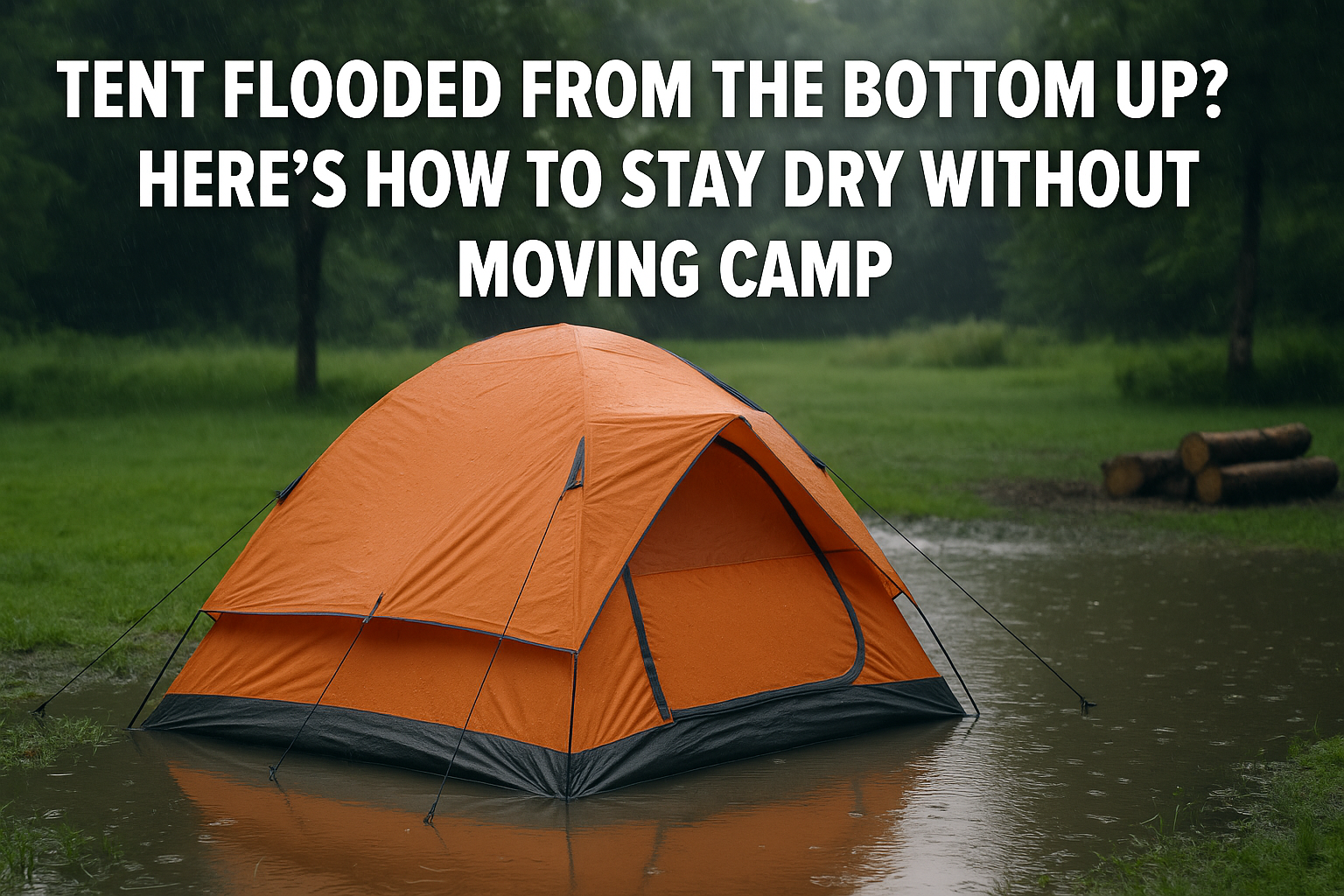When your tent floor turns to soup and your bag is half-submerged, most advice is useless. You’re not “about to get wet” — you’re already there. And you can’t move camp. The forest is saturated, the rain’s still falling, and you’re soaked from underneath with no dry patch in sight.
This isn’t a time for “pitch higher ground” or “lay down a towel.” This is how to survive a base-level flood when you’re cornered, cold, and surrounded by water — using nothing but what you already packed.
These solutions aren’t from REI. They’re from cold nights, bad judgment, and not-dying-when-you-should’ve experience.
🔥 Strategy 1: Flip Your Tent’s Physics — Make Water Work For You
💡 Concept: Don’t fight water. Leverage it to reshape your sleeping environment.
🧠 1. Pressure Pouch Insulation: Convert a Waterlogged Floor into Thermal Lift
Problem: Water has pooled under your tent. Your sleeping bag’s damp. The ground is ice-cold.
Fix:
- Use your dry bag, compression sack, or even your rain jacket’s hood.
- Scoop in clean rainwater — yes, on purpose.
- Seal it and slide it under your hips, back, or pad.
Why it works:
Water is a poor conductor of heat if it’s not moving — and it’s more stable than soaked gear or cold earth.
By lifting your core off the wet floor with controlled, sealed water, you reduce thermal siphoning from the cold ground.
It’s the reverse of flotation gear — using water as the neutral pressure medium under your sleeping area.
🧠 2. Float-Lock Your Pad Using Air Displacement
Problem: Your foam or inflatable pad is soaked underneath and moving around in pooled water.
Fix:
- Blow extra air into the pad, past comfort level.
- Use your backpack cover or plastic liner to create a second layer below.
- Let the two float over the water like a raft, then anchor them at the corners with shoes, pots, or rocks.
Why it works:
You’re removing contact points that cause pressure leaks.
The pad becomes a raft, not a mattress — and your body becomes the anchor.
Now, even in a thin layer of water, you’re floating on stability, not soaking in it.
🔥 Strategy 2: Isolate Dry Zones Above the Tent Floor (Even in a Single-Wall)
🧠 3. Overhead Hammocking Without Trees
Problem: Tent floor is fully compromised, no overhead branches, no time to rig a tarp shelter.
Fix:
- Use guy lines or shoelaces to rig a suspended gear net between the two tent poles inside your dome tent.
- Anchor opposite corners to pack straps, boots, or the corners of your mat.
- Place your sleeping bag in the net (yes, off the floor) — crawl in and shift weight toward the sides.
Why it works:
You’re treating your tent like a parabolic shelter, turning tension into loft — and avoiding contact with the flood zone entirely.
Optional: Stuff your wet gear in a compression sack and place it under the net as a ballast.
🧠 4. Human-Shell Shelter: Sleep Inside a Nested System
Problem: Every surface is wet. You can’t trust your pad, bag, or clothes.
Fix:
- Strip to base layer.
- Crawl into your dry bag (empty) or rain fly.
- Place that inside your sleeping bag (even if it’s damp).
- Wrap your wet bag around that — reversed.
Why it works:
This is a reverse bivy system.
Your core heat stays locked in the driest layer. Everything else becomes external insulation, even if wet.
You’re treating your tent like a Russian doll of misery, and your dry skin stays central.
🔥 Strategy 3: Convert the Tent Interior Into a Moisture Chimney
🧠 5. Thermal Draft Stack Using Boiled Water Vapor
Problem: The air inside is cold, damp, and condensation is dripping from the ceiling.
Fix:
- Boil water in your pot (if your stove still works).
- Place it in the center of the tent on a metal lid or rock.
- Crack both the lowest door zipper and highest ceiling vent just 1 inch.
Why it works:
Hot vapor rises. Moist air leaves the tent via upward draw, and you don’t lose body heat in the process.
This creates a passive upward thermal chimney — drying the tent air, not the gear.
It prevents ceilings from raining on you due to condensation buildup — a huge win in stormy nights.
🧠 6. Z-Fold Your Body to Create Self-Circulating Heat Zones
Problem: Even insulated, you feel like a wet freezer burrito.
Fix:
- Curl in a Z-shape — knees to chest, then straighten one leg at a time every 10 minutes.
- Tuck your hands into your armpits, not pockets.
- Keep your mouth inside your bag liner, but breathe outward toward the foot of the tent.
Why it works:
You’re shifting blood to your core, keeping your legs from going numb, and pushing wet exhalation away from your head, preventing inner-bag condensation.
This is how you stay warm in a wet bag without drying out the insulation.
🔥 Strategy 4: Tactical Flood Routing Inside the Tent
🧠 7. Create a Pressure Sink Using Gravity Bags and Your Food Sack
Problem: Water keeps creeping back toward you no matter what you mop or shift.
Fix:
- Fill your hydration bladder or dry sack with stones or water.
- Place it in the exact center of the tent’s lowest spot.
- Slightly elevate your sleeping area with boots, rocks, or your pack.
Why it works:
The heavy sack becomes a gravitational water anchor — attracting the flow to itself and stealing pressure away from your sleeping zone.
You’re controlling water movement by force redirection, not absorption.
🧭 Final Words: The Tent Is Dying. You Aren’t.
A soaked tent floor is a gear failure.
A wet sleeping bag is a morale killer.
But not adapting is what actually ruins the trip — or ends it.
You can’t dry the forest.
You can’t call in help.
But you can float yourself, redirect pressure, build above the mess, and turn your tent into a layered shelter system using physics, not guesswork.
And when the sun rises?
You’ll still be there. Dry enough to eat. Warm enough to think.
And smarter than 99% of the campers who would’ve panicked.

